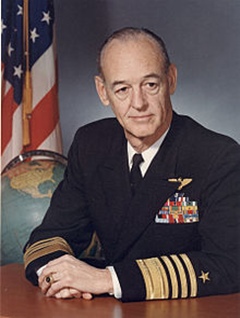THACH-JOHN
JOHN SMITH "JIMMY" THACH

ADM

FAMOUS FOR DEVELOPING THE “THACH WEAVE”
John Smith Thach was one of the most influential naval aviators of the mid-twentieth century and is credited with the creation of the Thach Weave, one of the most significant tactical advances in the history of aerial combat. He was awarded the Navy Cross and Distinguished Service Medal for developing this tactical maneuver, which remains a standard of military aviation.
Thach graduated from the U.S. Naval Academy in 1927 and was commissioned an Ensign. Assigned to battleships until entering flight training in 1929, he was designated a Naval Aviator in 1930 and over the next decade he gained a reputation as an expert in aerial gunnery, a test pilot and instructor. During World War II, as a Lieutenant Commander, he led the Wildcat F4F Fighting Squadron Three (VF-3) from aircraft carriers in early Pacific actions and became an ace. He was credited with developing the fighter combat technique known as the "Thach Weave" which contributed materially to the success against the Japanese at the Battle of Midway and many other battles. Properly executed, the “Thach Weave” permitted two Wildcat fighters to equal 4 to 5 Japanese Zeros in combat. After a period of instructing other pilots in combat tactics, he was promoted to Captain of carrier task force operations and was present at the Japanese surrender in Tokyo Bay on September 2, 1945.
After the war he served in several air training staff assignments, was promoted to Rear Admiral and commanded a carrier fleet in the Korean War. In the 1950s, he held a number of assignments including command of the antisubmarine development unit Task Group Alpha, Deputy Chief of Naval Operations for Air in the Pentagon and was promoted to Vice Admiral in 1960. Appointed to Full Admiral in February 1965, he was Commander in Chief of the U.S. Naval Forces, Europe, until his retirement in May 1967. His awards include the Distinguished Service Medal, two Navy Cross Medals, Silver Star Medal, two Legion of Merits and a Bronze Star Medal. The missile frigate USS THACH (FFG-43) was commissioned and named in his honor in March 1984.
ADM Thach died on April 15, 1981, in Coronado, California, and was buried at Fort Rosecrans National Cemetery in San Diego.
NAVY CROSS CITATIONS
(1) The President of the United States of America takes pleasure in presenting the Navy Cross to Lieutenant Commander John Smith Thach, United States Navy, for extraordinary heroism in operations against the enemy while serving as Pilot of a carrier-based Navy Fighter Plane and Commanding Officer of Fighting Squadron Three (VF-3), attached to the USS LEXINGTON (CV-2), when on 20 February 1942, in enemy waters, he led his Squadron in repeated attacks against two nine-plane formations of Japanese twin-engine heavy bombers which resulted in the destruction of sixteen of the eighteen enemy aircraft engaged. Through his courage and skill he shot down one enemy bomber, and with the assistance of his teammates, shot down a second bomber. Lieutenant Commander Thach's outstanding courage, daring airmanship and devotion to duty were in keeping with the highest traditions of the United States Naval Service.
(2) The President of the United States of America takes pleasure in presenting a Gold Star in lieu of a Second Award of the Navy Cross to Lieutenant Commander John Smith Thach, United States Navy, for extraordinary heroism and distinguished service in operations against the enemy while serving as Pilot of a carrier-based Navy Fighter Plane and Commanding Officer of Fighting Squadron Three (VF-3), attached to the USS YORKTOWN (CV-5), in action against enemy Japanese forces during the "Air Battle of Midway," on 4 June 1942. Pursuing the bold and fearless tactics of a great fighter and a skillful airman, Lieutenant Commander Thach led a division of his squadron on a mission providing protection for our own attacking torpedo squadron. Facing intense anti-aircraft fire, the squadron under his efficient command, attacked an overwhelming number of enemy Japanese fighters, shooting down three of them. Again, in the afternoon, he led a determined and effective attack against enemy torpedo planes which were attacking his carrier, shooting down one of them in this engagement. His great courage, inspiring example and his complete disregard for his own personal safety were in keeping with the finest traditions of the United States Naval Service.
Submitted by CDR Roy A. Mosteller, USNR (Ret)

